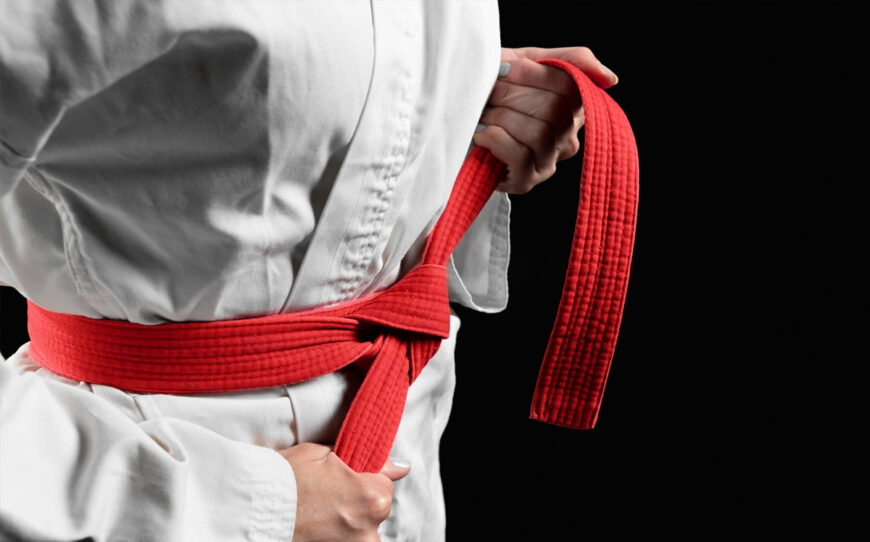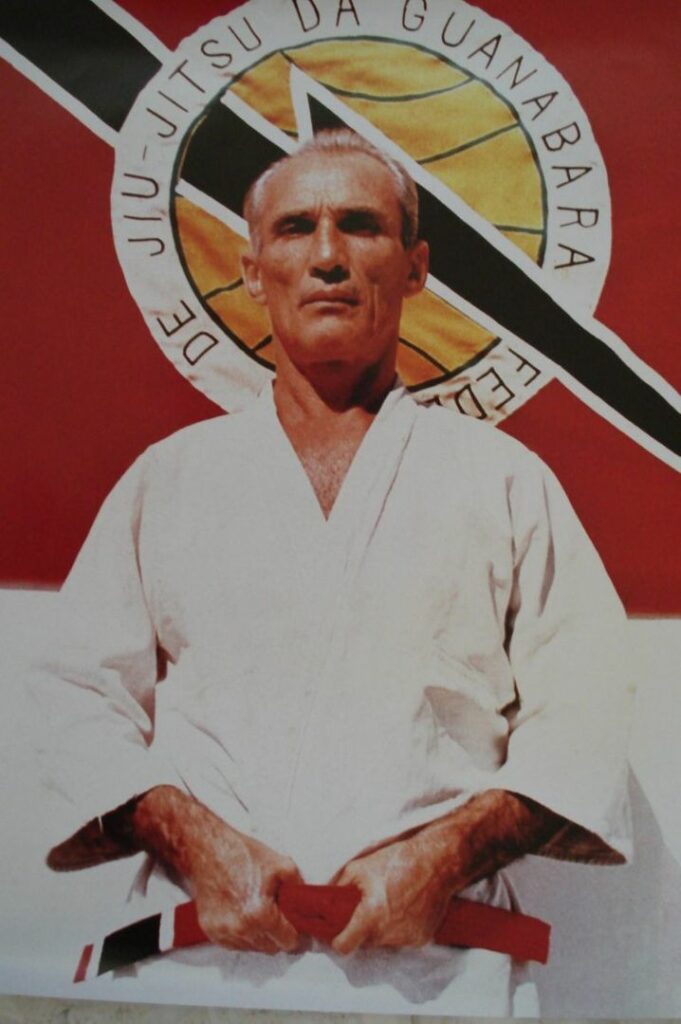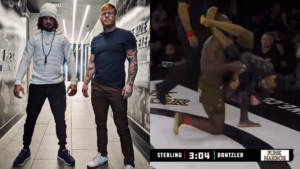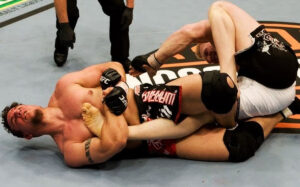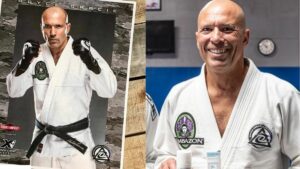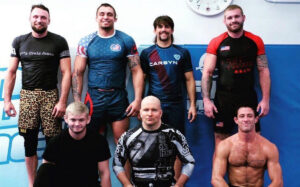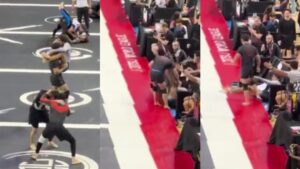In the world of martial arts, the journey to mastery is often symbolized by the belts worn by practitioners. One such pinnacle of achievement in Brazilian Jiu-Jitsu (BJJ) is the prestigious and elusive BJJ Red Belt, a rank held only by a select few who have dedicated their lives to this multifaceted discipline.
As you immerse yourself in this blog post, you’ll discover the rich history, significance, and legacy behind BJJ’s highest attainable rank for living practitioners.
Key Takeaways
- The BJJ red belt is the highest achievable rank in Brazilian Jiu – Jitsu, representing mastery and expertise in the art.
- Attaining red belt status requires not only technical proficiency but also significant influence and contributions to BJJ through leadership, innovation, and passion for the martial art.
- Notable BJJ red belt holders have made important contributions to the development of Brazilian Jiu-Jitsu, including Helio Gracie’s creation of Gracie Jiu-Jitsu, Rickson Gracie’s philosophy of “flowing with the go,” Carlos Gracie Sr.’s creation of the Gracie Diet, Oswaldo Fadda’s expansion of BJJ into new areas and communities.
The Significance of The BJJ Red Belt
The BJJ red belt is a symbol of the highest level of achievement in Brazilian Jiu-Jitsu, representing mastery and expertise in the art.
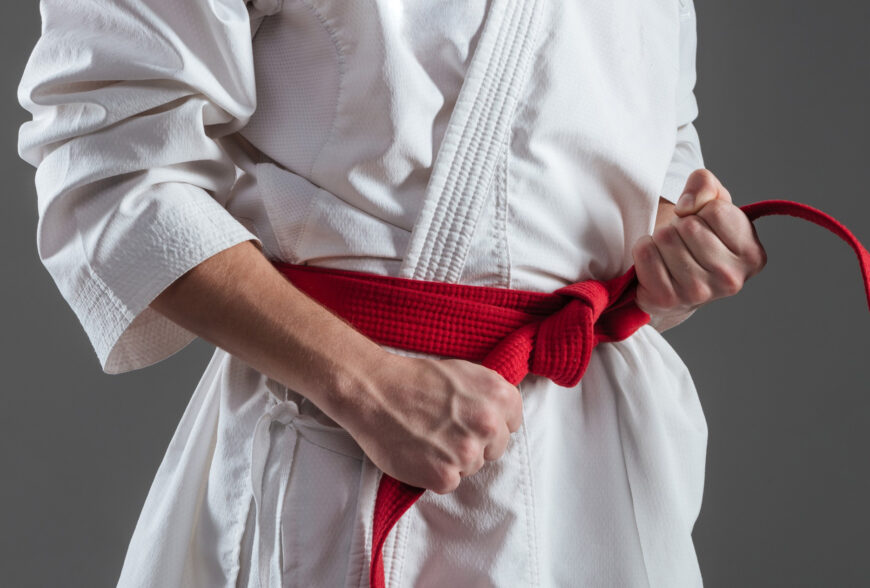
An Overview Of Brazilian Jiu Jitsu’s History And Origins
Brazilian Jiu Jitsu (BJJ) has a rich history and can trace its origins back to the early 20th century, when Mitsuyo Maeda, a Japanese Judo expert, arrived in Brazil. At that time, he befriended Gastão Gracie and began teaching his style of martial art to Gastão’s son Carlos Gracie.
Throughout the years, Brazilian Jiu Jitsu continued to evolve as it was passed down through generations of the Gracie family. Each member contributed their knowledge and refined various aspects of BJJ’s techniques, creating what is now known as Gracie self-defense or Gracie jiu-jitsu.
Today, we see thousands of Brazilian jiu-jitsu practitioners across all continents who engage in rigorous training sessions and showcase their skills in international tournaments at different belt levels ranging from white belts for beginners up until black belts for experts.
The Criteria For Achieving Red Belt Status
Attaining the prestigious BJJ Red Belt requires a lifetime of dedication, effort, and mastery within the Brazilian Jiu-Jitsu community. Practitioners must exhibit exceptional skills in teaching, competing, and advancing the martial art to be considered for this honor.
The journey towards achieving red belt status is not limited solely to technical proficiency or mastery but also encompasses significant influence and contributions to Brazilian Jiu-Jitsu.
As an example, Helio Gracie played a crucial role in developing Gracie Jiu-Jitsu – refining traditional Japanese techniques into what we know today as modern BJJ – earning him his well-deserved red belt.
Similarly, Rickson Gracie’s ability to flow with his opponent’s movements earned him recognition within the community and ultimately led to his promotion to 9th degree red belt.
The Role Oof Red Belts In The BJJ Community
Red belts hold an esteemed position within the Brazilian Jiu-Jitsu (BJJ) community, serving as mentors, leaders, and authoritative figures.
As custodians of immense knowledge and skill in the martial art, their role revolves around guiding future generations of practitioners and preserving BJJ’s rich traditions.
In addition to being respected teachers, red belts also play a vital part in fostering camaraderie within the global BJJ network. They use their fame and influence to promote growth by organizing seminars, competitions, and events where aspiring martial artists can learn from one another while showcasing their skills.
Learn everything about Brazilian jiu-jitsu belt system.
Notable BJJ Red Belt Holders And Their Contributions
Helio Gracie, often called the father of Brazilian Jiu-Jitsu, developed the self-defense style known as Gracie Jiu Jitsu; Rickson Gracie is famous for his philosophy of “flowing with the go,” which emphasizes adaptability and flexibility in grappling; Carlos Gracie Sr.
Helio Gracie And The Development Of Gracie Jiu Jitsu
Helio Gracie is one of the most influential figures in the history of Brazilian Jiu-Jitsu. He and his brothers developed the famous Gracie Jiu-Jitsu system, an effective form of self-defense used by law enforcement and military personnel around the world.
Despite suffering from health issues throughout his life, including a bout with chronic kidney disease, Helio continued training into his 90s and remained involved in the development and promotion of BJJ until his death at age 95.
Rickson Gracie And The Art Of Flowing With The Go
Rickson Gracie is widely recognized as one of the greatest BJJ practitioners of all time and a BJJ red belt holder. His approach to Jiu-Jitsu is based on the principle of “flowing with the go,” which emphasizes fluid, natural movement over brute force or aggression.
Gracie was also known for his exceptional ability to read his opponents and anticipate their moves, making him nearly unbeatable in competition.
Throughout his career, Gracie has been instrumental in spreading awareness about Brazilian Jiu-Jitsu both within martial arts circles and beyond.
Carlos Gracie Sr. And The Creation Of The Gracie Diet
Carlos Gracie Sr. was a legendary figure in Brazilian Jiu-Jitsu and is known for revolutionizing the way BJJ practitioners approach their diet. He created the “Gracie Diet,” which emphasizes food combinations to optimize digestion, absorption, and utilization of nutrients.
The Gracie Diet has become an integral part of BJJ training, with many top fighters adhering to its principles. It is a testament to Carlos Gracie Sr.’s forward-thinking mindset and his desire to improve not only his own performance but also that of his students.
Oswaldo Fadda And His Contribution To The Expansion Of BJJ
Oswaldo Fadda was a Brazilian Jiu-Jitsu (BJJ) Grandmaster who is often overlooked in the martial arts history books. Despite this, his contribution to the growth and expansion of BJJ cannot be ignored.
Fadda’s most significant contribution to BJJ came when he created his own academy and began training students from different social backgrounds, including those living in Brazil’s favelas or slums.
His efforts helped bring BJJ to new areas where it wasn’t accessible before, which led to an increase in the number of practitioners and competitions.
Other Notable Red Belt Holders And Their Accomplishments
The list of BJJ red belt holders who have achieved the highest possible rank in Brazilian Jiu-Jitsu is quite exclusive. Here are some other notable figures who have reached this pinnacle of mastery and made important contributions to the art:
Luis Carlos Guedes de Castro
Luis Carlos Guedes de Castro, one of Oswaldo Fadda’s initial black belt recipients, provided self-defense training to Rio de Janeiro’s police force for numerous years.
Reyson Gracie
Reyson Gracie was a formidable Vale Tudo and Jiu Jitsu champion, never suffering a defeat. He is widely recognized for popularizing BJJ in the Brazilian state of Amazonas.
Pedro Hemeterio
Pedro Hemeterio, the foremost student of Helio Gracie, spent 30 years instructing at the Sao Paulo State University after gaining his black belt.
Jose Higeno
Jose Higeno, a student of Master Aderbal Baptista from the Oswaldo Fadda lineage, was a Vale Tudo fighter in his youth who later established his own fight promotion.
Armando Wridt
Armando Wridt remained unbeaten as a Vale Tudo fighter in the 1950s. He is one of the seven red belts recognized by Helio Gracie.
Francisco Mansor
Francisco Mansor, one of Helio Gracie’s few students, earned his red belt from the martial art grandmaster. Mansor founded the renowned Kioto BJJ academy, which has produced a multitude of Jiu Jitsu champions.
Robson Gracie
After two decades of Vale Tudo fighting, Robson Gracie was detained as a political prisoner in the 1960s. Presently, he serves as the president of the Jiu Jitsu Federation of Rio de Janeiro.
Renato Paquet
Renato Paquet was a versatile sportsman, a Jiu Jitsu red belt, a boxing champion, and a Judo black belt.
Relson Gracie
Relson Gracie, a descendant of Helio, was a reigning BJJ champion for 22 years consecutively. Currently based in Brazil, he leads the Relson Gracie Jiu-Jitsu Academy.
Joao Alberto Barreto
One of the renowned Barreto brothers, Joao was among Helio Gracie’s initial BJJ students. He fought in Vale Tudo in his youth before dedicating his life to teaching.
Geraldo Flores
Geraldo Flores, a follower of the Oswaldo Fadda lineage, contributed to the establishment of BJJ in northern Rio de Janeiro.
Rorion Gracie
Rorion Gracie, a prominent son of Helio Gracie, gained acclaim for his role in creating the UFC. He also established the inaugural Gracie Jiu-Jitsu Academy on American soil.
Carley Gracie
Carley Gracie, son of omoplata master Clark Gracie, was the pioneer who introduced martial arts to the United States. He manages his school in California.
Deoclecio Paulo
Master Deo Paulo has been practicing Jiu Jitsu since the 1940s. He is one of the original disciples from the Oswaldo Fadda lineage.
Carlos Antonio Rosado
Carlos Antonio Rosado was the only student of the late Carlson Gracie to receive a BJJ red belt directly from Carlson himself. Rosado holds the distinction of being the youngest recipient of this rank.
Carlson Gracie
Carlson Gracie, a prodigy of Carlos Gracie Sr., made his name as a remarkable BJJ and Vale Tudo competitor. He is highly esteemed for establishing the Carlson Gracie affiliation, a powerhouse that nurtured some of the most skillful BJJ players.
Renato Paquet
Renato Paquet was a versatile sportsman, a Jiu Jitsu red belt, a boxing champion, and a Judo black belt.
Reylson Gracie
In 1974, Reylson Gracie became one of the initial Gracie sons to inaugurate their academy. He is also acclaimed for the creation of numerous martial art techniques, including the mata leao, or Rear-Naked-Choke.
Marcus Soares
Marcus Soares, a student of Carlson Gracie, played a significant role in popularizing Jiu Jitsu in Canada.
Reyson Gracie
Reyson Gracie, Carlos Sr.’s third son, played a crucial part in bringing Jiu Jitsu to the Amazonas, particularly in the state of Bahia in Brazil.
Oswaldo Paqueta
Oswaldo Paqueta, a close friend of Carlson Gracie, has been practicing Jiu Jitsu since the 1950s.
Carley Gracie
Carley Gracie, son of omoplata master Clark Gracie, was the pioneer who introduced martial arts to the United States. He manages his school in California.
Wilson Mattos
As one of Oswaldo Fadda’s oldest students, Wilson Mattos achieved the 9th degree red belt. He has managed his own school, Equipe Mestre Wilson, since the 1970s and has affiliates worldwide.
Flavio Behring
A past Jiu Jitsu champion, Flavio Behring is celebrated for launching the influential Behring Jiu Jitsu affiliation.
Francisco Sa
Francisco Sa is celebrated for introducing Jiu Jitsu to the northern Brazilian region of Ceara. In the 1960s, he journeyed to the region and established his Jiu Jitsu school.
Alvaro Barreto
In the 1950s, Alvaro Barreto emerged as one of the top non-Gracie BJJ athletes. Alongside his brothers and Oswaldo Fadda, he helped found Equipe Barreto, one of the first non-Gracie Jiu Jitsu schools.
Pedro Valente Sr.
Pedro Valente Sr., a close associate of Helio Gracie, began his training under him in 1953. Valente Sr. was also a war veteran and a renowned plastic surgeon in Brazil.
Paulo Mauricio Strauch
Paulo Mauricio Strauch, an original student of Reylson Gracie, has been a teacher for five decades and instructed everyone from Caio Terra to Alexandre Vieira.
Sergio Barreto
Sergio Barreto, the youngest of the Barreto brothers, co-established the Barreto Jiu Jitsu school and affiliation.
Reylson Gracie
Reylson Gracie, Carlos Sr.’s third son, played a crucial part in bringing Jiu Jitsu to the Amazonas, particularly in the state of Bahia in Brazil.
Geny Rebelo
Geny Rebelo, a student of Helio Gracie, is acclaimed for opening the esteemed Serrana Academy.
Crezio Chavez
Crezio Chavez, a Gracie Jiu Jitsu disciple and an undefeated fighter in the 1950s, is credited with propagating Jiu Jitsu in Petropolis, a city in the state of Rio de Janeiro.
Francisco Mansor
Francisco Mansor, one of Helio Gracie’s few students, earned his red belt from the martial art grandmaster. Mansor founded the renowned Kioto BJJ academy, which has produced a multitude of Jiu Jitsu champions.
Nahum Rabay
Nahum Rabay, a student of 10th-degree red belt George Gracie, is also recognized as a notable Brazilian musician.
Carlos Antonio Rosado
Carlos Antonio Rosado was the only student of the late Carlson Gracie to receive a BJJ red belt directly from Carlson himself. Rosado holds the distinction of being the youngest recipient of this rank.
Helio Vigio
Helio Vigio, a Gracie Jiu Jitsu student, was a Vale Tudo fighter in the 1950s. He later became one of Brazil’s most prominent referees.
Derval Luciano Rego
Derval Luciano Rego, also known as Master Morcego, co-founded the CBJJ and subsequently the IBJJF with Carlos Gracie Jr.
Ricardo Murgel
Ricardo Murgel, a BJJ red belt, was mentored by fellow BJJ red belt, Flavio Behring.
Carlson Gracie
Carlson Gracie, a prodigy of Carlos Gracie Sr., made his name as a remarkable BJJ and Vale Tudo competitor. He is highly esteemed for establishing the Carlson Gracie affiliation, a powerhouse that nurtured some of the most skillful BJJ players.
Robson Gracie
After two decades of Vale Tudo fighting, Robson Gracie was detained as a political prisoner in the 1960s. Presently, he serves as the president of the Jiu Jitsu Federation of Rio de Janeiro.
Joao Alberto Barreto
One of the renowned Barreto brothers, Joao was among Helio Gracie’s initial BJJ students. He fought in Vale Tudo in his youth before dedicating his life to teaching.
Reyson Gracie
Reyson Gracie, a formidable Vale Tudo and Jiu Jitsu champion, never suffered a defeat. He is widely recognized for popularizing BJJ in the Brazilian state of Amazonas.
Oswaldo Paqueta
Oswaldo Paqueta, a close friend of Carlson Gracie, has been practicing Jiu Jitsu since the 1950s.
Carlos Antonio Rosado
Carlos Antonio Rosado was the only student of the late Carlson Gracie to receive a BJJ red belt directly from Carlson himself. Rosado holds the distinction of being the youngest recipient of this rank.
Pedro Hemeterio
Pedro Hemeterio, the foremost student of Helio Gracie, spent 30 years instructing at the Sao Paulo State University after gaining his black belt.
Francisco Sa
Francisco Sa is celebrated for introducing Jiu Jitsu to the northern Brazilian region of Ceara. In the 1960s, he journeyed to the region and established his Jiu Jitsu school.
Flavio Behring
A past Jiu Jitsu champion, Flavio Behring is celebrated for launching the influential Behring Jiu Jitsu affiliation.
José Higeno
José Higeno, a student of Master Aderbal Baptista from the Oswaldo Fadda lineage, was a Vale Tudo fighter in his youth who later established his own fight promotion.
Geraldo Flores
Geraldo Flores, a follower of the Oswaldo Fadda lineage, contributed to the establishment of BJJ in northern Rio de Janeiro.
Crezio Chavez
Crezio Chavez, a Gracie Jiu Jitsu disciple and an undefeated fighter in the 1950s, is credited with propagating Jiu Jitsu in Petropolis, a city in the state of Rio de Janeiro.
Helio Vigio
Helio Vigio, a Gracie Jiu Jitsu student, was a Vale Tudo fighter in the 1950s. He later became one of Brazil’s most prominent referees.
Paulo Mauricio Strauch
Paulo Mauricio Strauch, an original student of Reylson Gracie, has been a teacher for five decades and instructed everyone from Caio Terra to Alexandre Vieira.
Nahum Rabay
Nahum Rabay, a student of 10th-degree red belt George Gracie, is also recognized as a notable Brazilian musician.
Deoclecio Paulo
Master Deo Paulo has been practicing Jiu Jitsu since the 1940s. He is one of the original disciples from the Oswaldo Fadda lineage.
These individuals have demonstrated exceptional knowledge, skill, and character through their journey to achieving BJJ red belt status. By achieving this rarefied distinction and sharing their insights with others, they have contributed greatly to the evolution and elevation of Brazilian Jiu-Jitsu as both an art form and sport.
Debunking Misconceptions About BJJ Red Belts
Clarifying the myth of the 10th-degree black belt, there is no official rank beyond the red belt in BJJ, and it is only awarded to individuals who have demonstrated a lifetime of dedication and mastery of the martial art.
Clarifying The Myth of The 10th Degree Black Belt
There is a common misconception in the martial arts community that the 10th degree black belt is the highest rank attainable in Brazilian Jiu-Jitsu (BJJ). However, this is not accurate.
In BJJ, only a red belt can be considered as the highest possible ranking for a practitioner. The 10th-degree black belt does exist but it’s typically an honorary rank given to individuals who have contributed significantly to their respective martial art.
It’s important to note that achieving the red belt requires years of dedication and hard work, mastering every aspect of BJJ and contributing positively to its growth.
The Rarity Of Red Belts And Their Continued Training And Growth
The red belt is the highest rank attainable in Brazilian Jiu-Jitsu (BJJ), and only a few practitioners have achieved it. In fact, there are currently just five men known to possess this coveted belt.
However, attaining the red belt does not signify the end of training or growth within BJJ. Rather, it marks a lifetime commitment to mastering and sharing one’s knowledge with others.
One notable example of a red belt who continues to train and grow in BJJ is Helio Gracie’s son Rickson Gracie. Despite holding this esteemed title for many years now, Rickson still trains regularly at his academy in California.
He encourages his students to pay attention to small details when executing techniques while emphasizing flow over forcing moves.
Preserving The Legacy And Future of The BJJ Red Belt
Red belts play an important role in passing down traditions and values to future generations of BJJ practitioners, and their continued mentorship and training is crucial for the growth of the art.
The Role Of Red Belts In Passing Down Traditions And Values
Red belts play a crucial role in passing down the traditions and values of Brazilian Jiu-Jitsu (BJJ) to future generations of practitioners. These individuals have spent decades mastering the art and embodying its principles, making them valuable mentors for younger students.
One notable example is Helio Gracie, who founded Gracie Jiu Jitsu alongside his brother Carlos. Helio was known for his dedication to teaching the art of BJJ to anyone who wanted to learn it, regardless of their background or ability level.
He believed that BJJ had the power to change lives for the better and worked tirelessly throughout his life to pass down this belief to others.
The Importance Of Mentorship And Continued Training
Mentorship and continued training are crucial in the journey towards achieving BJJ Red Belt status. One can never fully master Brazilian Jiu-Jitsu, as there is always something to learn, whether it be a new technique or strategy.
The guidance of a mentor, someone with more experience and knowledge of the art, is invaluable in this process.
Furthermore, continued training ensures that practitioners maintain their skills and proficiency in BJJ. It allows them to stay up-to-date with new techniques and strategies while also helping them improve upon existing ones.
Consistent training instills discipline, patience, humility, and dedication – all essential qualities for achieving success in any field – including martial arts.
The Future Of The Red Belt And Its Impact On BJJ
The significance of the red belt in Brazilian Jiu Jitsu cannot be overstated, and its future impact on the sport is a topic of great interest to many martial arts fans. As fewer and fewer practitioners reach the level required for this achievement, it’s thought that the rarity of this highest rank will only increase its prestige.
Additionally, with BJJ growing in popularity around the world, there’s an increasing need for legends like Helio Gracie and Rickson Gracie – who achieved red belt status during their lifetimes – to inspire new practitioners striving for excellence.
Finally, as more athletes turn to BJJ for competition or personal development purposes, achieving a red belt may become an even greater symbol of mastery in both traditional martial arts circles and mainstream culture at large.
Achieving BJJ Red Belt Status
To achieve BJJ red belt status, one must show a lifetime of dedication and mastery of the art through consistent training and advancement in Brazilian Jiu-Jitsu; read on to discover more about this prestigious rank.
A Guide To Training And Advancement In Brazilian Jiu Jitsu
If you aspire to achieve the rank of BJJ red belt, it is essential to train regularly and always strive to improve your skills. Below are some tips on how to advance in Brazilian Jiu Jitsu:
- Find a reputable academy with experienced and knowledgeable instructors who can guide you through each belt level.
- Train consistently and make it a habit to attend classes regularly. Consistent training helps build muscle memory and retention of techniques.
- Focus on improving your fundamentals before moving on to advanced techniques. Strong fundamentals are essential for building a strong foundation in BJJ.
- Practice both gi and no-gi grappling to develop a well-rounded set of skills.
- Attend seminars and workshops hosted by top-level instructors or Brazilian Jiu-Jitsu grand masters who have reached the 9th or 10th degree in BJJ.
- Participate in competitions as much as possible, as they provide an opportunity for you to test your skills against other practitioners, gain experience and learn from your mistakes.
- Study match footage of top – level competitors, analyze their techniques, and try to incorporate them into your game.
- Always be open – minded, humble, and willing to learn from everyone, regardless of their rank or experience level.
By following these guidelines, you can work towards achieving the highest level of proficiency or mastery in Brazilian Jiu-Jitsu. Remember that dedication and hard work are key when striving for the coveted BJJ red belt.
Building Your Skills, Knowledge, And Reputation In The BJJ Community
Achieving the coveted red belt status in BJJ requires a lifetime of dedication, discipline, and training. To build your skills, knowledge, and reputation in the BJJ community, it is essential to consistently practice and hone your techniques.
It is equally important to learn from established practitioners and mentors who have achieved higher ranks in BJJ. Seeking out opportunities for mentorship can provide valuable guidance on how to advance within the community while maintaining humility and respect for others.
FAQs
1. What is a BJJ Red Belt and how long does it take to earn one?
A BJJ Red Belt represents the highest level of achievement in Brazilian Jiu-Jitsu (BJJ) and is typically awarded after several decades of dedicated practice. There is no set time frame for earning this rank as it varies depending on individual progress, skill, and commitment within the art.
2. Can anyone achieve the rank of BJJ Red Belt?
No, not everyone has the ability or dedication needed to earn a BJJ Red Belt. This rank is typically reserved for only the most elite practitioners who have devoted their lives to mastering all aspects of BJJ including technique, strategy, physical fitness and mental fortitude.
3. How can I improve my chances of achieving a BJJ Red Belt?
The best way to increase your chance of earning a Red Belt in BJJ is through consistent practice over many years with experienced instructors who can guide you along your journey. It’s also important to focus on developing strong fundamentals in grappling techniques while also incorporating strategic approaches that enhance your overall game plan.
4. Are there any famous red belt holders in Brazilian Jiu-Jitsu?
Yes! A few notable examples include Carlos Gracie Sr., Helio Gracie, Jean Jacques Machado and Rickson Gracie – all pioneers within Brazilian Jiu-Jitsu who were instrumental in shaping its growth into one of the world’s most popular martial arts today.
Conclusion
In conclusion, the BJJ red belt is the pinnacle of achievement in Brazilian Jiu-Jitsu. It is a tribute to those who have spent their entire lives pursuing mastery of the art.
The rare and illustrious nature of this distinction makes it legendary and awe-inspiring.
As we look towards the future, it is crucial that we preserve the legacy and traditions passed down by these great masters. The role of mentorship and continued training will help ensure that future generations uphold these values for years to come.
The path may be challenging but rewarding with perseverance throughout your journey through each rank until you reach the top – becoming an exemplar practitioner worthy of a revered place among legends in Brazilian Jiujitsu’s history.
More on BJJ:
- Which Martial Art Black Belt Takes The Longest Time?
- The 7 Best Martial Arts For Self-Defense
- How To Choose The Right Martial Art?
- The Ultimate Brazilian Jiu Jitsu Guide For Beginners
- Best Ways To Improve Flexibility For Brazilian Jiu-Jitsu
- Workouts To Build Explosive Strength For Jiu-Jitsu
- Why Your Jiu-Jitsu Isn’t Getting Better

